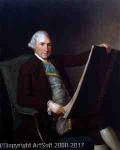Robert Adam
Robert Adam
Miejsce: Kirkcaldy
Urodzony: 1728
Śmierć: 1792
Biografia:
Robert Adam FRSE FRS FSA FSA FRSA (3 July 1728 – 3 March 1792) was a Scottish neoclassical architect, interior designer and furniture designer. He was the son of William Adam (1689–1748), Scotland's foremost architect of the time, and trained under him. With his older brother John, Robert took on the family business, which included lucrative work for the Board of Ordnance, after William's death.
In 1754, he left for Rome, spending nearly five years on the continent studying architecture under Charles-Louis Clérisseau and Giovanni Battista Piranesi. On his return to Britain he established a practice in London, where he was joined by his younger brother James. Here he developed the "Adam Style", and his theory of "movement" in architecture, based on his studies of antiquity and became one of the most successful and fashionable architects in the country. Adam held the post of Architect of the King's Works from 1761 to 1769.
Robert Adam was a leader of the first phase of the classical revival in England and Scotland from around 1760 until his death. He influenced the development of Western architecture, both in Europe and in North America. Adam designed interiors and fittings as well as houses.
He served as the member of Parliament for Kinross-shire from 1768 to 1774.
Adam was born on 3 July 1728 at Gladney House in Kirkcaldy, Fife, the second son Mary Robertson (1699–1761), the daughter of William Robertson of Gladney, and architect William Adam. As a child he was noted as having a "feeble constitution". From 1734 at the age of six Adam attended the Royal High School, Edinburgh where he learned Latin (from the second year lessons were conducted in Latin) until he was 15, he was taught to read works by Virgil, Horace, Sallust and parts of Cicero and in his final year Livy. In autumn 1743 he matriculated at the University of Edinburgh, and compulsory classes for all students were: the Greek language, logic, metaphysics and natural philosophy. Students could choose three elective subjects, Adam attended classes in mathematics, taught by Colin Maclaurin, and anatomy, taught by Alexander Monro primus. His studies were interrupted by the arrival of Bonnie Prince Charlie and his Highlanders, who occupied Edinburgh during the 1745 Jacobite rising. At the end of the year, Robert fell seriously ill for some months, and it seems unlikely that he returned to university, having completed only two years of study.
On his recovery from illness in 1746, he joined his elder brother John as apprentice to his father. He assisted William Adam on projects such as the building of Inveraray Castle and the continuing extensions of Hopetoun House. William's position as Master Mason to the Board of Ordnance also began to generate much work, as the Highlands were fortified following the failed Jacobite revolt. Robert's early ambition was to be an artist rather than architect, and the style of his early sketches in the manner of Salvator Rosa are reflected in his earliest surviving architectural drawings, which show picturesque gothic follies. William Adam died in June 1748, and left Dowhill, a part of the Blair Adam estate which included a tower house, to Robert.
On William Adam's death, John Adam inherited both the family business and the position of Master Mason to the Board of Ordnance. He immediately took Robert into partnership, later to be joined by James Adam. The Adam Brothers' first major commission was the decoration of the grand state apartments on the first floor at Hopetoun House, followed by their first "new build" at Dumfries House. For the Board of Ordnance, the brothers were the main contractor at Fort George, a large modern fort near Inverness designed by military engineer Colonel Skinner. Visits to this project, begun in 1750, would occupy the brothers every summer for the next 10 years, and, along with works at many other barracks and forts, provided Robert with a solid foundation in practical building.
In the winter of 1749–1750, Adam travelled to London with his friend, the poet John Home. He took the opportunity for architectural study, visiting Wilton, designed by Inigo Jones, and the Queens Hermitage in Richmond by Roger Morris. His sketchbook of the trip also shows a continuing interest in gothic architecture.
Among his friends at Edinburgh were the philosophers Adam Ferguson and David Hume and the artist Paul Sandby whom he met in the Highlands. Other Edinburgh acquaintances included Gilbert Elliot, William Wilkie, John Home and Alexander Wedderburn.
On 3 October 1754, Robert Adam in the company of his brother James (who went as far as Brussels) set off from Edinburgh for his Grand Tour, stopping for a few days in London, where they visited the Mansion House, London, St Stephen Walbrook, St Paul's Cathedral, Windsor, Berkshire, in the company of Thomas Sandby who showed them his landscaping at Windsor Great Park and Virginia Water Lake. They sailed from Dover arriving in Calais on 28 October 1754. He joined Charles Hope-Weir, brother of the Earl of Hopetoun in Brussels and together they travelled to Rome. Hope agreed to take Adam on the tour at the suggestion of his uncle, the Marquess of Annandale, who had undertaken the Grand Tour himself. While in Brussels the pair attended a Play and Masquerade, as well as visiting churches and palaces in the city. Travelling on to Tournai, then Lille, where they visited the Citadal designed by Sébastien Le Prestre de Vauban. By 12 November 1754 Adam and Hope were in Paris where they took lodgings in Hotel de Notre Dame.
More...
Wikipedia link: Click Here














